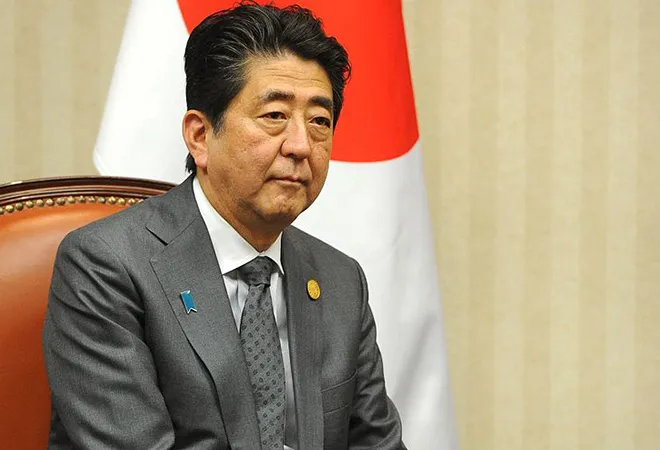-
CENTRES
Progammes & Centres
Location
Shinzo Abe, who returned to power in 2012, showed extraordinary interest in carrying out several measures in the Japan’s security sphere. But rather than bringing any reconciliation with the Okinawans, Abe’s measures seemed to place a stronger premium on the importance of the US bases in Okinawa.

Image Source: Dick Thomas Johnson — © Flickr/CC BY 2.0
Exactly ten days after his victory in the Liberal Democratic Party’s presidential election, Prime Minister Shinzo Abe faced a serious setback in the Okinawa gubernatorial election on 30 September. Atsushi Sakima, the LDP-Komeito supported candidate in the Prefectural election, was defeated badly by his rival candidate Denny Tamaki , a former member of the House of Representatives. The ruling LDP-Komeito geared up all its resources to support Sakima.
Ironically, the election campaign in Okinawa was in full steam when Abe himself was busy campaigning for his third presidential term. It was an interesting spectacle that many front ranking LDP leaders showed even greater interest in campaigning in the Okinawa gubernatorial election.
Pitted against Sakima was Denny Tamaki who was supported by the main opposition parties including the Constitutional Democratic Party. Considering himself as the successor to Takeshi Onaga, former governor of Okinawa, who fought vigorously against the Central government for the rights of the Okinawans, Tamaki was able to rally the support of the anti-base sentiments of the Okinawans.
For the central government, Okinawa is an indispensable element in its security alliance with the US. But the Okinawans have always contended that the Tokyo government in its eagerness to please the US has ignored the basic interests of the islands.
The battle lines between the central government and the prefectural administration were drawn on the issue of the central government’s keenness to shift the Futenma US marine base from the present crowded Ginowan area to the distant city of Nego of Henoko district. This was a compromise arrangement made by the US and the central government to assuage the feelings of the Okinawans who have always demanded that the base be removed altogether from the prefecture.
This is not a new issue and its roots should be seen in the basic grievances of the islanders who have articulated that their legitimate interests as Japanese citizens have been subordinated to the larger “strategic demands” of the US-Japan security alliance. It has been a major source of embittered relations between the central government and the prefecture. Over the years, the gulf between the two has been widening leading to a crisis of confidence between the two. For the central government, Okinawa is an indispensable element in its security alliance with the US. But the Okinawans have always contended that the Tokyo government in its eagerness to please the US has ignored the basic interests of the islands.
Accounting for just less than one per cent of the total territories of Japan, Okinawa hosts a disproportionally large bulk of American military bases on its soil. They complain that the US military bases have given rise to serious crimes, social tensions, and environmental degradation. During 2009-12 when the Democratic Party was in power, it took up the question of vacating the military bases from the islands with the US. But the negotiations between the two clearly demonstrated Washington’s stubborn position on the need to maintain its bases for promoting its security interests. Unable to bring relief to the islanders, Prime Minister Hatoyama reigned. His two successors Naoto Kan and Yoshihiko Noda did not have the political clout to deal with the issue.
Accounting for just less than one per cent of the total territories of Japan, Okinawa hosts a disproportionally large bulk of American military bases on its soil.
Abe, who returned to power in 2012, showed extraordinary interest in carrying out several measures in the security sphere. But rather than bringing any reconciliation with the Okinawans, Abe’s measures seemed to place a stronger premium on the importance of the US bases in Okinawa. Takeshi Onaga who became the governor of Okinawa in 2014 spearheaded a movement against the central government and insisted that the Futenma base be shifted out of the prefecture. The islanders rallied around him and he became a symbol of Okinawa’s aspirations. He took several measures to halt the shifting of the Futenma base to another place within the prefecture.
When Onaga died suddenly in August, many believed that the islanders had lost an effective champion of their rights and that the anti- base movement itself would suffer seriously. But the election of Tamaki as the governor has aroused a new hope that he would carry forward the legacy of Onaga.
With the newly elected Governor Tamaki firmly committed to his anti-base campaign, there is need for both sides to find some common meeting ground. A prefectural referendum on the question of the relocation of the Futenma base is scheduled to be held during the spring of 2019. Even before that, it would be very necessary for Abe to initiate the process of dialogue with Tamaki instead of merely talking about the strategic importance of the Okinawa base. The widening gap between Tokyo and Okinawa has to be brought to an end and that is possible only if Abe takes effective steps to take the islanders into confidence in a true spirit of reconciliation.
The views expressed above belong to the author(s). ORF research and analyses now available on Telegram! Click here to access our curated content — blogs, longforms and interviews.

K.V. Kesavan (1938 2021) was Visiting Distinguished Fellow at ORF. He was one of the leading Indian scholars in the field of Japanese studies. Professor ...
Read More +